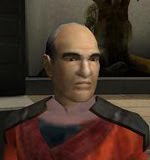Having loved math since an early age (I was a big fan of Square One on PBS), I've enjoyed reading Rosalind's Mathematical Monday posts over at Girls Are Geeks. Her post today on family genetics got me thinking about one of my favorite bits of math-related genetic trivia, inspiring me to write a Mathematical Monday post of my own.
Bees, and other members of the family Hymenoptera (e.g. ants, wasps, hornets), have a peculiar genetic characteristic in that the females are diploid, or have two sets of chromosomes, while the males are haploid, or have one set of chromosomes. Humans, and most of the animals that we are familiar with, are all diploid; we get one set of chromosomes from our mother, and one set from our father. In Hymenoptera, a female gets one set of chromosomes from her mother and one set from her father, but a male only gets one set from his mother and has no father. Basically, an unfertilized egg develops into a male while a fertilized egg will become a female. This fascinating genetic trait actually helps explain the colonial behavior observed in many Hymenoptera, including honeybees. Why? The answer is in the math.
Consider humans. A mother has two sets of chromosomes--two sets of each gene. She mates with a man who also has two sets of each gene (with the odd exception of the Y chromosome vs. X chromosome, but we need not get into that complication for these purposes). Her offspring will receive 50% of their genes from her, and 50% from her mate. So the parents will share 50% of their genes with each of their children. What's more, these offspring in turn share on average 50% of their genes with each other. It's a little harder to see this, but imagine that one offspring has already been born, with one set of genes coming from his mother and another set coming from his father. Since the mother has two sets of genes to give, as does the father, the chance that a second offspring will have the same version of any particular gene that the first offspring has is 50%: 50% chance of getting the same hair color gene from the mother (since she has two), 50% chance of getting the same hair color gene from the father (since he has two), 50% chance of getting the same maternal eye color gene, etc. This can be put in a sort of rough formula as follows, where we take this idea that on average one out of every two genes from the mother (and father) will be the same between siblings.
(1 gene similar with sibling/out of every 2 genes from mother) * 50% of genes come from mother + (1 gene similar with sibling/out of every 2 genes from father) * 50% of genes come from father = 25% + 25 % = 50% genes similar with sibling
Now consider a honeybee (I focus on them because they were the specialty of my college biology professor). A queen bee producing female offspring is, like humans, 50% related to her daughters; the daughters get 50% of their genes from the mother and 50% of their genes from their father. However, while a honeybee has a 50% chance of sharing any particular maternal gene with one of her sisters, because the father only has one set of genes, she has a 100% chance of sharing every paternal gene with her sisters. To make an analogous formula,
(1 gene similar with sister/out of every 2 genes from mother) * 50% of genes come from mother + (1 gene similar with sister/out of every 1 gene from father) * 50% of genes come from father = 25% + 50% = 75% genes similar with sisters
Note: I ignore the males because they are kind of a lost cause--in honeybee colonies, they can't be workers, and their only role is to mate, then die ;)
So a honeybee shares more in common genetically with her sisters (75% on average) than she would with her offspring (50%). Therefore, a female honeybee's genes are actually better propagated by her having more sisters than by having children of her own. This may explain why honeybees and other members of Hymenoptera colonize, letting one "queen" (really, just a baby-making sucker) produce children while all the sisters take care of each other and the hive. This colony behavior may have been more successful in propagating genes than other tactics, and so the behavior was successfully passed on throughout the generations.
Monday, February 21, 2011
Subscribe to:
Post Comments (Atom)
















2 comments:
Oh, fun stuff! I was almost an entomologist for a bit, but I decided I liked smaller bugs better (microbiology). But, I gave a lecture on human sex chromosomes last week and briefly mentioned some of the species with different sex chromosomes than X/Y. Fun stuff!
Cool! Yeah, nature is pretty amazing, especially in the small guys that we don't know much about from day-to-day life. Hooray for the little bugs.
Post a Comment